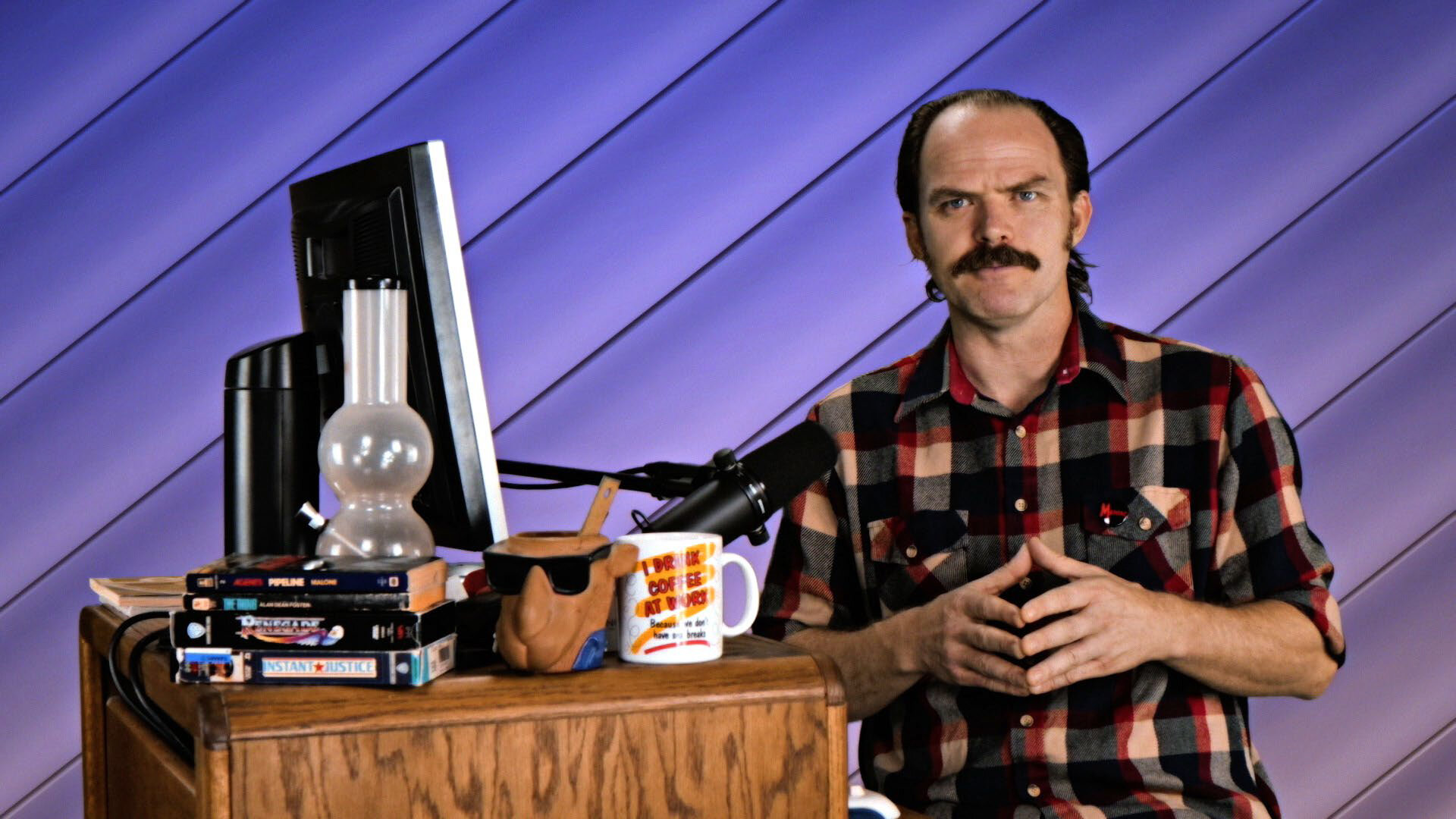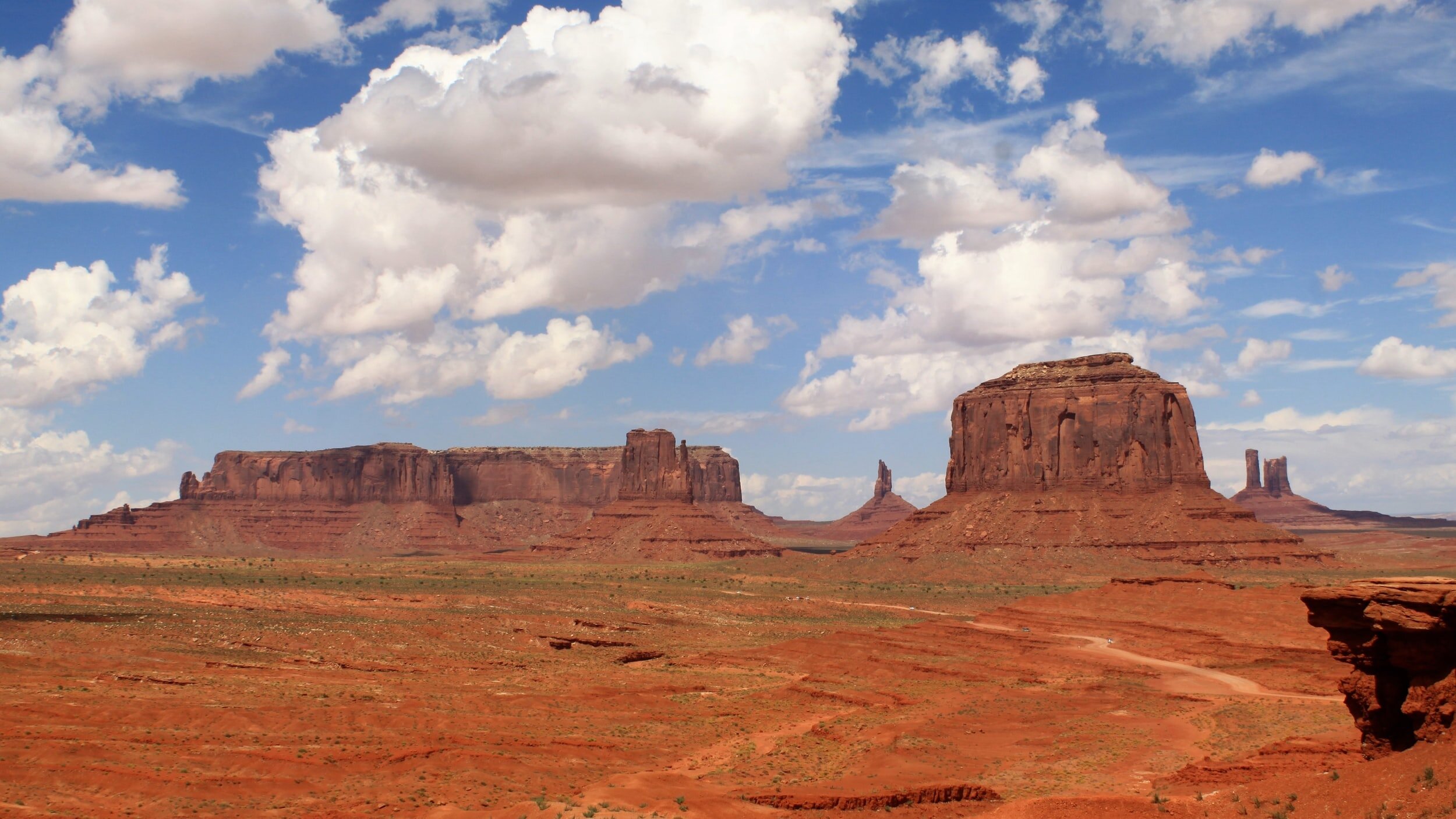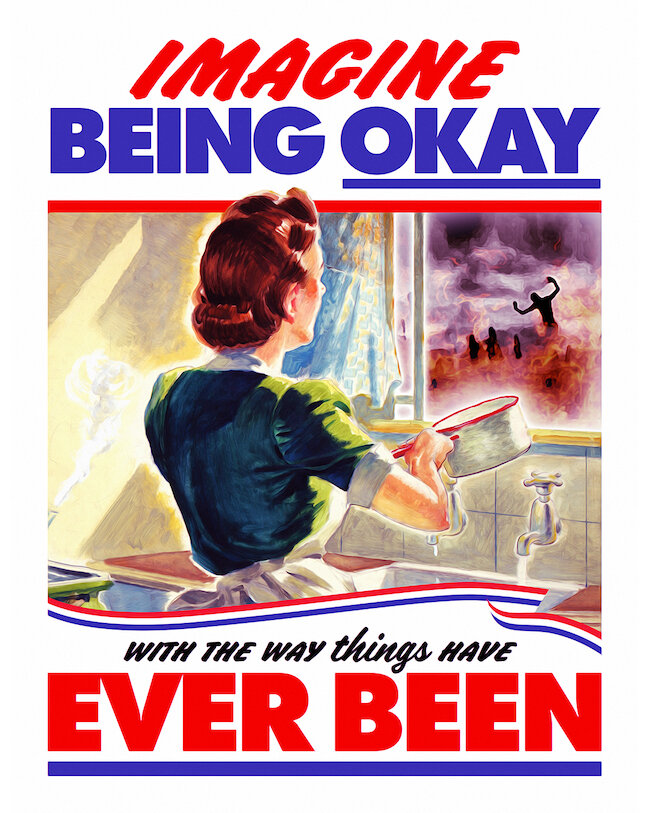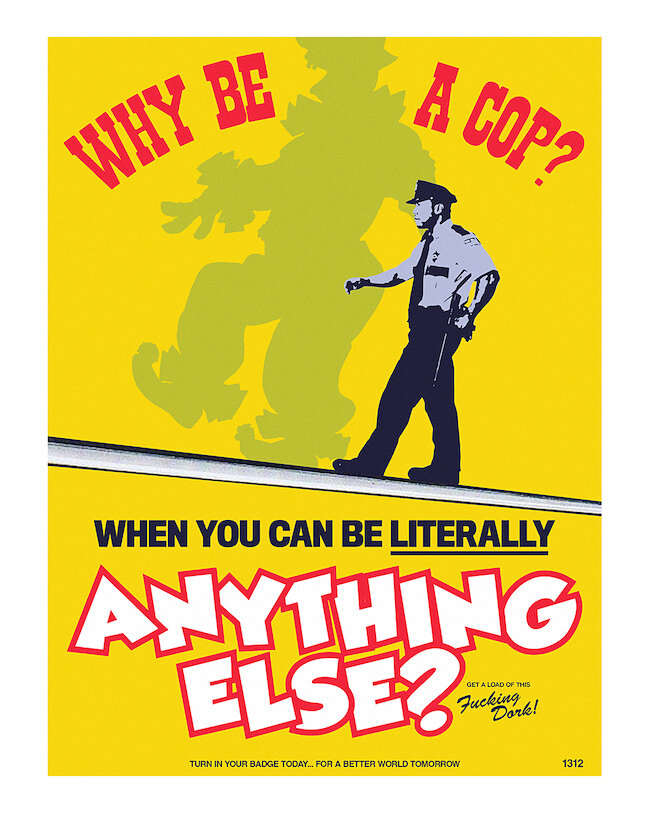
Feature | Arts + Culture
An Interview with Teenage Stepdad
Interviewed by Clara Dudley | 28 May 2021
“I’m Teenage Stepdad, a balding middle-aged man who creates art under an Internet pseudonym.
You have a computer in your pocket, and that’s not just a tool of consumption; it can be a tool of creation…
Even if all you make is dumb, weird, stupid bullshit.”
On 9 June 2021, streaming service newcomer Means TV releases Seize the Memes with Teenage Stepdad, the alt meme scion’s first streaming series: “A new Means TV original series that explores the rise of DIY digital meme art, in these...the last days of American Empire.” (Read more: “Let’s Make Some Fucking Art!” [20 April 2021, Means TV on Medium.com])
From the signature low-fi world of Teenage Stepdad – which appears to exist inside a stuttering late-1980’s television set like the trapped ghosts of Poltergeist - Seize the Memes is an original instruction series for DIY digital artwork that “encourages you to reject any and all art instruction. Seriously.” Aesthetically, think: a community college art teacher in the Stranger Things universe, straddling a curious yet comfortable line between Bob Ross and a benevolent Hunter S. Thompson.
Teenage Stepdad is the pseudonym and brainchild of Nathan Sims, a California-bred/Arizona-based digital meme artist known for a distinctly Internet-ready brand of Marxist philosophy, raunchy humour, and a pantheon of fictional characters engaged in some pretty strained family relations.
“Eventually, the unexpected viral cult success of his Pamplemousse La Croix memes in 2016 - a side project posted mostly on a Facebook page - led to some widespread attention, and the rest is history. ”
A Pamplemousse La Croix meme from the early days of Teenage Stepdad
Sims’ path to alt-Internet stardom is based in a self-taught career in art and graphic design for print, digital and merchandise. Eventually, the unexpected viral cult success of his socially critical Pamplemousse La Croix memes - a side project posted mostly on a Facebook page starting in 2016 - led to some widespread attention, and the rest is history.
Known for unapologetically (and often hilarious) biting critiques of American culture, capitalism, police, and systemic racism through meme art rendered in vintage design styles or motion graphics, Sims has since worked as “Teenage Stepdad” with Will Smith, Mad Magazine, The Lonely Island, Super Deluxe, Red Bull Esports, High Times Magazine - and now, Means TV. He also offers free “propaganda” on his website, set up for distribution in easily-printed formats.

Typical Teenage Stepdad memes
Seize the Memes was shot and produced entirely by Sims in an Arizona garage during the COVID-19 pandemic. And it seems a more perfect home for Teenage Stepdad’s niche media kingdom could not reasonably exist: in their own words, Means TV is “the world’s first worker-owned, post-capitalist streaming service.” It launched in 2019, emerging from the founders’ Detroit-based production company Means of Production, which notably created Alexandria Ocasio-Cortez’s viral docu-style campaign video in 2018. Featuring original short series, news, and films, it is completely ad-free and supported entirely on viewers’ fees.
Seize the Memes Trailer
But most importantly, Means TV programming is curated with a critically discerning eye to the power politics of media and representation. Writes Luke Ofttenhof of the Guardian (14 April 2020), “Means follows a simple metric for determining suitability of content: ‘Is this punching up or down? Is this going after people that have more power than us, or is this denigrating people that have less power than us?’”
This kindred left-wing solidarity – accessible web-based media firmly rooted in an anti-capitalist ethos – is the connective tissue to Teenage Stepdad’s work.
In this interview, we chatted about Sims’ unconventional career path, the origins of the project and his unique creative style, the NFT phenomenon, the state of America, and what gives him hope for his children’s future.
Interviewed on 16 May 2021. Edited for length and clarity
…
Tell us a bit about Seize the Memes – what is it and why do you make it? Was it an idea looking for a home, and how did it come to be?
The idea had been in the back of my mind for about four years - this idea of doing something inspired by the shows I grew up with, like This Old House and The Joy of Painting – stuff that my dad was really fond of. And in particular, this lesser-known carpentry show, New Yankee Workshop with Norm Abram - who was the master carpenter of This Old House – that was on an old WGH Boston public access channel.
Bob Ross of The Joy of Painting
As I started meme-ing, I’d get these [direct messages] all the time from people asking me, “What software do you use? Would you ever do tutorials?” That got the nugget of this idea brewing, of doing something in that format.
So, about four years ago, I started correspondence with a strictly comedy outlet – who I won’t name – and they were interested in it. But at the same time there was talk of toning down the more crude elements, and a bit of the political bite that I had envisioned for it. Because my vision wasn’t to make a tutorial show – I have no interest in teaching people how to be creative; I’m a big believer in being self-taught, and pursuing your passions above all else.
Then, I saw what Means TV were doing, and was really interested in it. I used to do a lot of professional work that was political with Super Deluxe, and after they were gone I didn’t really have an outlet for that anymore. And I never do this, but I reached out to them and said, “I see what you’re doing, I think we would be good to team up.” After that relationship had built for a while, I asked what they’d think of longer form work.
So eventually, what was formerly known as Meme Studio with Teenage Stepdad – well, it became clear that it was supposed to be Seize the Memes, and that could encompass a bit more of that radical look of what art can be a mechanism for.
You reference and build nostalgia into your work a lot, especially for the Millennial coming-of-age aesthetics of the ‘80s and ‘90s. What is it about that aesthetic that you gravitate towards - is there something about escapism that is important there, or is it just style?
There’s so many reasons, and I’ll leave the big one to the end. Generally, I feel like the pre-computer, pre-modernist design era is so much richer. I feel really lucky that I haven’t had to adopt a style; I can jump around from decade to decade. I always liked the way that [pre-digital era] looked, and if I want to pull that off, I figure out how to do it.
There’s so much from that era of design – the 1960s through the 1990s – where things were done on paper, or done as paste-ups; when people were doing transfer letters from catalogues, and there was a lot more illustration.
“I want my work - when you look at it all together on these social platforms - to look like the ultimate thrift store shelf ...”
There’s a lot of cool work that happens with computer-aided and modernist design - but even the good stuff in that format doesn’t speak to me or who I am as a person, as much. Because I’ve always thought of life as being extremely messy and diverse and textured and imperfect, and the more that design is fed to us by people who are design school graduates and who follow that kind of path, the less it has to do with the lives of me and the people I know.
A late 1980s retro-inspired meme
I think that’s a large part of my success: people are scrolling on social media and seeing the gradients with the font infographic-style stuff, and its everywhere because it’s so easy. But with all these [design] tools available to us, we can do so much - and it doesn’t seem like we are using them. If it just took me 45 minutes to do my design, that’s not interesting; I want to get lost for six hours, I want to forget about the world for a bit.
Aesthetically, I like thrifting, and I want my work - when you look at it all together on these social platforms - to look like the ultimate thrift store shelf that you would stumble on, with all this great-looking cool stuff.
I hadn’t thought of this until recently, if I’m super honest about why I’m stuck in that era with my artwork – including the influences of This Old House and New Yankee Workshop – is because that’s what everything looked like when my dad was still around; the era it’s set in was around the time that I lost him. It makes me feel comforted to revisit that and put myself back in that space where things made a little more sense for me and life was a little less confusing.
Why do you feel that creative expression is so important for people and society?
Looking back on my life, I’ve always done something creative; working my shitty jobs, the thing that always gave me a sense of self was what I was able to do in my free time through creating shit.
“This capitalist hellscape - is dependent on us feeling isolated and like things can’t change. And when you can put yourself into something you’ve made and share it with someone else, and they feel that in them, too, you feel connected.”
There was one year I remember – I think I was working in print at the time - at the end of the day, I just had no juice left inside because I was working on other people’s shit all day. And I remember that year being miserable and having no sense of self. I forgot who I was, what I thought and what I believed in. For me, I feel miserable when I don’t have that inside me.
At the most basic level, going through the art process is revealing to yourself what’s inside you, more than anything. I think of the simple term: “It helps you to become real.” It connects you to who you are inside. And that’s weird to say for a guy who makes a bunch of jokes about “boaners” and diarrhea. But I think that stuff also comes from getting out of the way of your own expression – it’s not all of who I am, but it’s part of who I am; I think that’s funny.
With political art, this system we live under - this capitalist hellscape - is dependent on us feeling isolated and like things can’t change. And when you can put yourself into something you’ve made and share it with someone else, and they feel that in them, too, you feel connected. Then, you do that on the Internet and it multiples by thousands and thousands, and you think, “I made this weird thing that felt true to me and others respond to it.”
They’re feeling less alone, and you’re all feeling less alone – there are those connections. And that can be the beginning of some big changes. It’s a means of building solidarity.
One of the major flaws of the Internet was the ‘share’ button. Instead of just expressing what’s inside of themselves, people share what others have created - and those people who have made those things can be really cynical and terrible and more media-savvy than most others. And if these tools weren’t around to just adopt created opinions, maybe we wouldn’t be in a lot of the messes we’re in with the Internet.
The way to avoid that is for people to stop using the ‘share’ button and start expressing themselves on their own. And I’m all for using the reach I have through that mechanism to get people to look at the device in their hand and use it not only as a tool of consumption, but a tool of creation, too.
How do you feel that memes can act as a political tool?
Sometimes, I just set out to make straight-up propaganda. I think of what Lenin said: ‘great propaganda is taking a truth and presenting it in a way that’s compelling to as many people as possible’.
And some pieces are created with that in mind. Everything I make is a meme but not everything is widely shared, or is intended to be. Digital art and the pieces created as propaganda are, for me, a way to get thoughts out.

It seems like what you’re doing is the antithesis to NFTs [non-fungible tokens] – how do you feel about NFTs and what do you think it’s doing to the nature of digital art?
Ok, so first thing I’ll say is - I did make some. I had this long thought process about it, and I had a lot to say about that space, and how a lot of great artists I admired weren’t making great art all the time but suddenly talking corny bullshit about ‘monetization’ and spreading that evangelism. So I had a lot of thoughts on it all. And I did end up making some, but I haven’t felt comfortable posting them. As each week goes by, the whole thing gets cornier and cornier.
My evolution of thinking about this is also that it could be a mechanism of wealth redistribution: take money from Libertarian dicks, and give it to trans rights organisations, for example; it could be a tool for working class and poor creators to extract wealth from the tech-bro class.
But the environmental stuff is also intense, on how destructive it is. Yet, at the same time, global capitalism is destroying the environment – and [that criticism] is still trying to put focus on the individual choices instead of making systemic changes. So, I’m not totally comfortable with it at the moment, but we’ll see.
In the Teenage Stepdad universe, you’ve created these characters, such as Uncle Gary and Grayson. Then, the real-life “Grayson” discovered on Twitter he had been a meme for years – what was it like for you to unite with the real Grayson?
That was something I was kind of terrified of for a while. My main bread and butter is that I use commercial imagery to skewer commercial culture – I don’t really try to take people’s personal stuff and use them…. So it’s not the most ethical thing I’ve done, taking this kid’s picture and making him into a whole character. But when I saw that picture he just became Grayson.
When Dr. Adrian Smith discovered he was ‘Grayson’
It was actually a really cool experience – the real “Grayson” is a bug scientist and content creator named Dr Adrian Smith; he’s a content creator in a different corner of the Internet, and he’s really cool. He makes these great videos I can show my kids. The other blessing is that he is all in on it – he loved the work, the character.
It could have ended with hurting someone’s feelings, because it may have seemed like I was teasing that kid, but really it was a way to tease myself at that time, at that age; to talk about my foibles when I was an awkward stepson to my wonderful stepfather and my mother. And he saw in it what I intended.
There were people on the Internet telling him to sue me, and his response was, “I love this and I’m gonna order a Grayson fan club shirt.” It was one of the most magical things to happen to me on the Internet. In the end, it made me feel a real connection with a real person.

“It was one of the most magical things to happen to me on the Internet. In the end, it made me feel a real connection with a real person. ”
“Terrible stepson” Grayson memes
What do you want young people in the future to have access to, and what do you want their society to look like?
“I want people to not feel that they’re born into something they can’t change – to have liberation from that.”
Liberation and dignity. And some stake in their future, some control over the outcomes that’ll affect their lives. Community, global proletarian solidarity, and a sense of belonging to something that has power. How we get there, that’s the question. And that’s what I want for my kids, for everybody. I want people to not feel that they’re born into something they can’t change – to have liberation from that. Last year, when everybody was in the streets [for the Black Lives Matter protests], that was maybe the only time I’ve ever felt hope for the future, and it was based on everyone exercising their power together. I want my kids to grow up with that being something that doesn’t happen only for a moment. When we all get out together and stand up for ourselves together, that’s the world I want them to live in.
What is the most hopeful and promising aspect of America? What gives you hope about the future of America right now?
The younger generation. Definitely not my generation, or my parents’, but that generation which has seen three economic collapses, watched police killing black people on videos every week, the generation that knows it’s all a lie, and has no faith in capitalism and all the failed institutions. The first step to getting there is abandoning that faith. And this generation has none of that faith; they know it’s all fucking bullshit. No one has to tell them that because they see it constantly.
“That’s what I have hope in, seeing collective action play out. Because it’s certainly not anything that happens in Washington, D.C., or at the voting booth.”
And this is coupled with a lot of hopelessness, too – that maybe there’s no faith it’ll get better, either. But the more things happen like the uprising last year, the more people see that and see, you know, a police station getting burned down and then shortly thereafter that area actually has some reforms that weren’t just lip service - that’s what I have hope in, seeing collective action play out. Because it’s certainly not anything that happens in Washington, D.C., or at the voting booth.
We saw when people stop working these shitty jobs and once the supply and demand stacks up in the favour of labour - even for a brief second - they immediately start scraping away unemployment benefits to coax people back to those jobs.
So my hope is that we learn that going back to normal is terrible and the best things we have ever seen in our lives is all of us standing out in the streets standing up for each other. That’s where I place my hope.
…
Seize the Memes premieres on Means TV on 9 June 2021. Check Means TV for more info and to subscibe.
….
Follow Teenage Stepdad on Instagram / Twitter / YouTube / Official Website
Follow Means TV on Instagram / Twitter / YouTube / Official Website
-Updated 3 June 2021
















